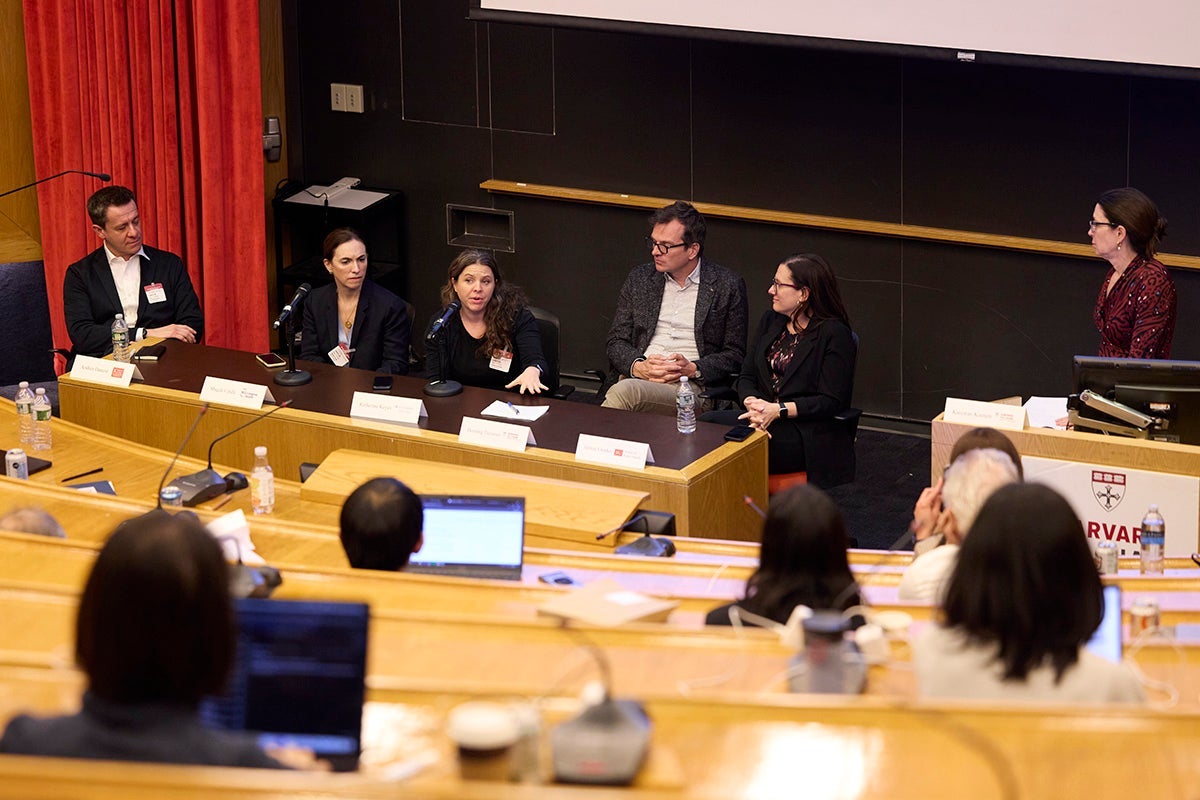Finding causes of population mental health problems challenging, say experts at symposium

November 21, 2024 – Teasing out the best ways to address widespread mental health problems depends on pinpointing their causes as accurately as possible. But that can be a big challenge for researchers, according to experts who spoke at a Nov. 15 Harvard T.H. Chan School of Public Health symposium.
The 18th Kolokotrones Symposium, jointly hosted by CAUSALab and the Population Mental Health Lab, focused on “Causal Inference for Population Mental Health.” The event marked the official launch of the Population Mental Health Lab, led by Karestan Koenen, professor of psychiatric epidemiology.
Speakers at the symposium dug into the methodological difficulties in connecting the dots between common mental health disorders and what drives them, noting that the ultimate goal of their research is to develop effective interventions that benefit broad segments of the population.
After an introduction from Albert Hofman, chair of the Department of Epidemiology, Koenen talked about the prevalence of mental health problems, primarily anxiety disorders, depression, and posttraumatic stress disorder (PTSD). She noted that, in the U.S., nearly one in four adults lives with a mental illness, and one in 20 lives with a serious mental illness—meaning that they have a mental health condition that interferes with daily functions such as going to school, working, being in a stable relationship, or managing money. Evidence has shown that the prevalence of mental disorders is on the rise, especially among youth; that mental disorders increase the risk of chronic disease and early death; and that a large percentage of people with mental disorders don’t receive any treatment.
She also pointed out that expanding traditional mental health treatment—talk therapy or medication—is not enough to quell the rising tide of mental health problems. “We need population-based solutions,” she said. “We need to expand our ideas of what interventions might be.” She offered one example, noting that research by Harvard Chan’s Rita Hamad suggests that policies that reduce economic stress among adults can also improve their mental health.
Research complexities
Symposium speakers touched on a range of mental health issues—including teen depression, opioid overdoses, child behavior problems, and PTSD—and outlined the challenges facing researchers trying to determine the effectiveness of various interventions for each issue.
Katherine Keyes of Columbia University’s Mailman School of Public Health discussed whether it makes sense to restrict adolescents’ use of social media to address depression. She noted that at least 30 states have pending legislation that would impose some kind of restrictions. But the evidence is unclear on whether doing so would necessarily help.
For example, a 2015 meta-analysis found that there is not a linear relationship between time spent on social media and youth well-being. Instead, youth with the lowest depressive symptoms were those who used screens or social media in moderate amounts. Other studies, she noted, have found that links between youth well-being and mental health differ by device (e.g., smartphone, tablet, or desktop computer), by type of application (e.g., Facebook, Instagram, WhatsApp, TikTok), by what feature is being used (e.g., status updates or profile updates), and by what types of interactions people are having in those social media spaces.
“These are the relevant constructs that we need to be talking about and not time spent on social media, which is too crude of a proxy to really draw any kind of causal conclusion,” Keyes said.
Magdalena Cerdá of NYU Langone Health spoke about the difficulty in evaluating whether local harm reduction laws can reduce opioid overdoses. Such laws may allow for the distribution of clean syringes, fentanyl test strips (which can detect the presence of fentanyl in drugs so that people can take steps to reduce their risk of overdose), centers where people can use drugs safely under supervision, or programs that distribute naloxone, which can reverse overdoses. But Cerdá noted that even the first step in evaluating the laws—gathering data about them—is a challenge, due to roadblocks such as paywalls or data that’s organized differently in different communities. Further, the interplay between local and state laws varies from state to state.
Cerdá said she hopes that innovations in artificial intelligence, causal inference, and legal epidemiology—the study of law as a factor in the cause, distribution, and prevention of disease and injury—can help identify the causal effect of local laws.
Other presenters at the symposium included Harvard Chan’s Henning Tiemeier, who spoke about several factors that can impact child mental health, such as screen time and bullying; Jaimie Gradus of the Boston University School of Public Health, who discussed whether PTSD treatment can help prevent cardiovascular disease; and Andrea Danese of King’s College London, who spoke about his work to better understand and mitigate the effects of childhood trauma on psychopathology.
Advancing the field
The symposium wrapped up with a panel discussion featuring all of the researchers. Koenen asked them what needs to happen next to advance causal inference in population mental health. Panelists offered several answers, including the need for better data, improved study design, and more methodological rigor.
The experts acknowledged the difficulties inherent in their research, but expressed commitment to working through those issues.
“The reason that I studied psychiatric epidemiology and psychiatric disorders is [their] importance for society and humanity,” said Keyes. “More than 80% of the population is going to experience a diagnosable psychiatric disorder at some point in their lives. And I guarantee you that every person in this room either has experienced or has someone in their family who’s experienced a serious psychiatric disorder. … We face challenges as a field, but there’s also a lot of growth that happens over the years. That’s exactly what gets me up in the morning.”
Photos: Kent Dayton


